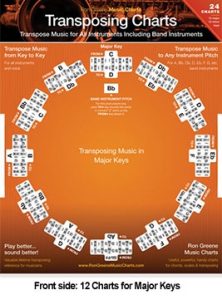Transposition Music Charts
Consider an example of a C major chord. The root note, C can be transposed to other keys by moving it up or down the scale. For example, the same chord in D major would be followed by the notes D-E-F-G-A. If we wanted to play this chord in A minor, it would go A-C#-E (or E as a sharp).
When musicians want to play music that has been written for a different key than they are playing it at, they will often transpose it. This is done either by playing an instrument in a different key or singing or performing with different instruments and voices that are tuned to match the notes of the song being played.
You might consider using a transposing chart…
– Like the Music Dials Transposition Chart
A single piece of sheet music could be used for many songs in different keys because all of these songs have at least one note which is common between them (i.e., they share at least one note with each other).
When sheet music is transposed into another key, not only do all of these common notes change but also some unexpected ones may change too! Often times there will be two options: one which uses sharps and another which uses flats.

